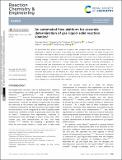An automated flow platform for accurate determination of gas–liquid–solid reaction kinetics
Author(s)
Duan, Xiaonan; Tu, Jiacheng; Teixeira, Andrew R.; Sang, Le; Jensen, Klavs F.; Zhang, Jisong; ... Show more Show less
DownloadPublished version (2.145Mb)
Publisher with Creative Commons License
Publisher with Creative Commons License
Creative Commons Attribution
Terms of use
Metadata
Show full item recordAbstract
An automated flow platform based on a tube-in-tube contactor and micro-packed bed reactor is developed to measure the kinetics of gas–liquid–solid hydrogenation reactions. The liquid flowing in the inner tube of the tube-in-tube contactor is rapidly saturated to ensure a constant H2 concentration before entering the micro-packed bed, which transforms the gas–liquid–solid system into a liquid–solid system. A ramping strategy is adopted in which the continuously varied residence time and the corresponding conversion data are obtained in a single experiment. Two reactions including hydrogenation of α-methylstyrene and nitrobenzene are chosen to demonstrate the accuracy and efficiency of this automated platform. Varying the flow rate ramping shows that accurate kinetic determination requires a specific range of flow rate ramps. A kinetic curve of conversion versus residence time (more than ten thousand data points) can be obtained in a single experiment within 50 min. The kinetic parameters obtained with this strategy agree well with literature values. The automated flow platform with flow rate ramping enables accurate determination of gas–liquid–solid reaction kinetics with higher efficiency and lower reagent cost compared with other methods.
Date issued
2020-07Department
Massachusetts Institute of Technology. Department of Chemical EngineeringJournal
Reaction Chemistry & Engineering
Publisher
Royal Society of Chemistry (RSC)
Citation
Duan, Xiaonan et al., "An automated flow platform for accurate determination of gas–liquid–solid reaction kinetics." Reaction Chemistry & Engineering 5, 9 (September 2020): 1751-1758 doi. 10.1039/D0RE00191K ©2020 Authors
Version: Final published version
ISSN
2058-9883